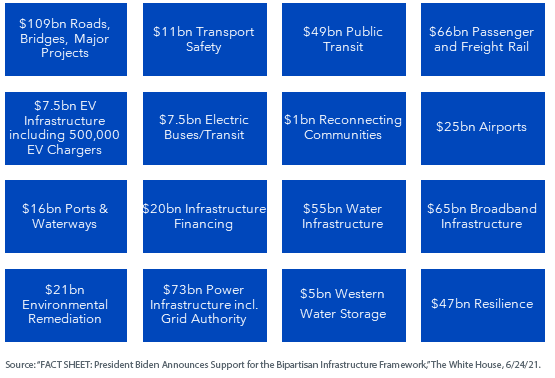Infrastructure Bill Beneficiaries Index Unresponsive To Date
A large number of companies should benefit considerably from the business that will be generated by the passage of the $1.2T infrastructure bill. We began by tracking 10 of those companies at the end of the year, in munKNEE's new Infrastructure Bill Beneficiaries Index. We've added two more companies to the list, for an even dozen members in the non-tradable index.
The Bipartisan Infrastructure Deal (Infrastructure Investment and Jobs Act) was passed by Congress on November 6th and signed into law by President Biden on November 15th with the objective of:
- easing inflationary pressures and strengthening supply chains by making long overdue improvements to U.S.’s ports, airports, rail, and roads
- expanding access to clean drinking water,
- ensuring every American has access to high-speed internet,
- tackling the climate crisis,
- advancing environmental justice,
- investing in communities that have too often been left behind,
- driving the creation of good-paying union jobs and
- growing the economy sustainably and equitably so that everyone gets ahead for decades to come.
Figure 2: U.S. Infrastructure Bill Spending Plans

The stock prices of the 12 constituents in the Infrastructure Bill Beneficiaries Index have not responded yet to anticipated dramatic increases in revenue and profits. Indeed, on average, the stock prices of 11 of the 12 constituents actually declined -8.9%, on average, in January with only Deere & Company advancing (+9.0%). Below we give their individual stock performances YTD, in descending order.
- Deere & Company (DE): +9.0% YTD
- as a major producer of earthmoving and roadbuilding and forestry equipment DE should see an increased demand for its machinery.
- Oshkosh Corp. (OSK): -0.7% YTD
- builds specialty trucks used in heavy construction projects as well as cement mixers, truck mounted cranes, "cherry pickers" and other hydraulic lifting systems and is well placed to meet the demand for the electrification of the federal vehicle fleet having recently won the contract to produce 165,000 new mail trucks.
- Caterpillar (CAT): -2.7% YTD
- as the manufacturer of asphalt pavers, compactors, excavators, pipe layers, backhoes CAT will benefit from future major infrastructure projects.
- Brookfield Infrastructure Corporation (BIPC): -4.4% YTD
- with operations spanning utilities, transportation, energy, and even data infrastructure, BIPC should benefit enormously from business generated by the infrastructure bill.
- United Rentals (URI): -4.4% YTD
- rents out typical construction equipment and specialty equipment specifically designed for underground work and fluid treatment which makes it well placed to benefit from the passage of the infrastructure bill.
- Vulcan Materials (VMC): -9.2% YTD
- as America's largest producer of construction aggregates such as crushed stone, sand and gravel, and as a major producer of asphalt and cement VMC should benefit from the passage of the infrastructure bill.
- Eaton Corp. (ETN): -9.3% YTD
- as a major supplier of electrical components and systems Eaton should benefit from the integration of wind and solar farms into the national grid.
- Nucor (NUE): -12.6% YTD
- as the largest domestic steelmaker in North America, the pent-up demand from automakers and other industrial buyers and the passage of the infrastructure bill should benefit NUE considerably going forward.
- Martin Marietta Materials (MLM): -13.1% YTD
- as the producer of crushed sand and gravel products, ready-mixed concrete and asphalt, and paving products and services, magnesia-based chemical products for industrial, agricultural and environmental applications, dolomitic lime for the steel and mining industries, and chemical products for use in flame retardants, wastewater treatment and assorted environmental applications, MLM should benefit considerably from the implementation of the infrastructure bill.
- Crown Castle International (CCI): -13.4% YTD
- as one of America's leading wireless tower real estate investment trusts (REITs), CCI should benefit from the expansion of mobile data usage.
- Freeport-McMoRan (FCX): -13.6% YTD
- given that 43% of all copper mined is used in building construction, with another 20% used in transportation equipment, FCX, as one of the world's largest and best-run copper miners, should be a major benefactor.
- ChargePoint Holdings (CHPT): -33.6% YTD
- is the leading EV charging infrastructure network provider in the United States building customized charging stations and the $7.5 billion in the bill will be enough to deliver about 250,000 new charging stations.
- That being said, its management contends that because, unlike its peers, it offers a wide range of software solutions, it is primarily a software company and, by doing that, it’s seeking to become a high-margin SaaS company. However, the results of its efforts don’t justify its lofty valuation. Its numbers pale compared to other SaaS stocks, yet it trades at over 26 times analysts’ average 2022 sales estimate . Consequently, the risk-reward ratio of CHPT stock is negative and the stock price has declined as a result of that assessment.
As noted above,
Visit munKNEE.com and register to receive our free Market Intelligence Report newsletter (sample more



